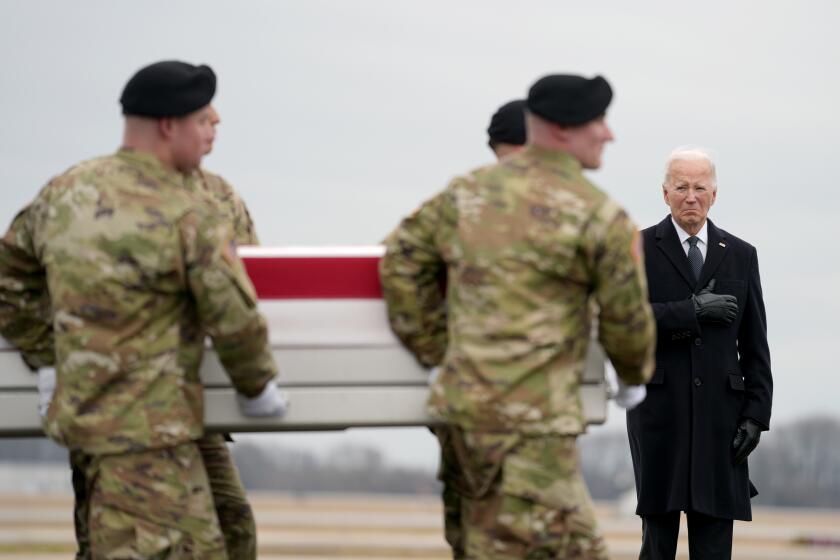U.S., U.K. again strike Houthi targets in Yemen

- Share via
WASHINGTON — The United States and Britain struck 36 Houthi targets in Yemen on Saturday in the latest wave of assaults meant to further disable Iran-backed groups that have relentlessly attacked American and international interests in the wake of the Israel-Hamas war.
The latest strikes against the Houthis were launched by warships and fighter jets. The strikes follow an air assault in Iraq and Syria on Friday that targeted other Iranian-backed militias and Iran’s Islamic Revolutionary Guard in retaliation for the drone strike that killed three U.S. troops in Jordan last weekend.
The Houthi targets were in 13 different locations and were struck by U.S. F/A-18 fighter jets from the USS Dwight D. Eisenhower aircraft carrier and by the USS Gravely and the USS Carney Navy destroyers firing Tomahawk missiles from the Red Sea, U.S. officials told the Associated Press.
They were not authorized to publicly discuss the military operation and spoke on condition of anonymity.
The U.S. warned that its response after the soldiers’ deaths at the Tower 22 base in Jordan last Sunday would not be limited to one night, one target or one group. But the Houthis have been conducting almost daily missile or drone attacks against commercial and military ships transiting the Red Sea and Gulf of Aden and they have made clear that they have no intention of scaling back their campaign. It was not immediately clear whether the allied assaults will deter them.
U.S. Defense Secretary Lloyd J. Austin III said in a statement that the military action, with support from Australia, Bahrain, Canada, Denmark, the Netherlands and New Zealand, “sends a clear message to the Houthis that they will continue to bear further consequences if they do not end their illegal attacks on international shipping and naval vessels.”
He added: “We will not hesitate to defend lives and the free flow of commerce in one of the world’s most critical waterways.”
The Defense Department said the strikes targeted sites associated with the Houthis’ deeply buried weapons storage facilities, missile systems and launchers, air defense systems and radars.
Saturday’s strikes marked the third time the U.S. and Britain had conducted a large, joint operation to attack Houthi weapon launchers, radar sites and drones.
The U.S. is striking sites in Iraq and Syria in retaliation for the drone attack that killed three American troops in Jordan, officials say.
The strikes in Yemen are meant to underscore the broader message to Iran that Washington holds Tehran responsible for arming, funding and training the array of militias behind attacks across the Mideast against U.S. and international interests over the last several months, including in Iraq and Syria by the rebels in Yemen.
Video shared online by people in Sana, Yemen’s capital, included the sound of explosions, and at least one blast was seen lighting up the night sky. Residents described the blasts as happening around buildings associated with the Yemeni presidential compound. The Houthi-controlled state-run news agency, Saba, reported strikes in numerous provinces.
On Friday, the U.S. destroyer Laboon and F/A-18s from the Eisenhower shot down seven drones fired from Houthi-controlled areas of Yemen into the Red Sea, the destroyer Carney shot down a drone fired in the Gulf of Aden and U.S. forces took out four more drones that were prepared to launch.
Hours before the latest joint operation, the U.S. took another self-defense strike on a site in Yemen, destroying six anti-ship cruise missiles, as it has repeatedly when it has detected a missile or drone ready to launch.
The U.S. has blamed the Jordan attack on the Islamic Resistance in Iraq, a coalition of Iranian-backed militias. Iran has tried to distance itself from the drone strike, saying the militias act independently.
Hussein al-Mosawi, spokesperson for Harakat al-Nujaba, one of the main Iranian-backed militias in Iraq, condemned the earlier U.S. strike in Iraq and said Washington “must understand that every action elicits a reaction.” But in the AP interview in Baghdad, he also struck a more conciliatory tone. “We do not wish to escalate or widen regional tensions.”
Al-Mosawi said the targeted sites in Iraq were mainly “devoid of fighters and military personnel at the time of the attack.”
Experts say Israel’s deadly raid on a West Bank hospital may have violated international laws, including a ban on combatants posing as doctors or civilians.
Rami Abdurrahman, who heads the Britain-based Syrian Observatory for Human Rights, said that 23 people were killed in the Syria strikes, all rank-and-file fighters.
An Iraqi government spokesperson had said in a statement that Friday’s strikes in Iraq near the Syrian border killed 16, including civilians, and there was “significant damage” to homes.
The U.S. said it had informed Iraq about the operation before it started.
A U.S. official said Saturday that an initial battle-damage assessment showed the U.S. had struck each of its planned targets in addition to a few “dynamic targets” that popped up as the mission unfolded, including a surface-to-air missile site and drone launch sites. The official, who spoke on condition of anonymity to provide details that were not yet public, did not yet have a casualty assessment.
The Iraqi government has been in a delicate position since a group of Iranian-backed Iraqi militias calling itself Islamic Resistance in Iraq began launching attacks on U.S. bases in Iraq and Syria on Oct. 18. The group described the strikes as retaliation for Washington’s support for Israel in the war in Gaza.
Behind the scenes, Iraqi officials have attempted to rein in the militias, while also condemning U.S. retaliatory strikes as a violation of the country’s sovereignty and calling for an exit of the 2,500 U.S. troops in the country as part of an international coalition to fight Islamic State. Last month, Iraqi and U.S. military officials launched formal talks to wind down the coalition’s presence, a process that will probably take years.
Associated Press writers Ahmed al-Haj in Sana, Yemen; Abdulrahman Zeyad and Ali Jabar in Baghdad; Abby Sewell and Bassem Mroue in Beirut; and Jon Gambrell in Jerusalem contributed to this report.
More to Read
Sign up for Essential California
The most important California stories and recommendations in your inbox every morning.
You may occasionally receive promotional content from the Los Angeles Times.















